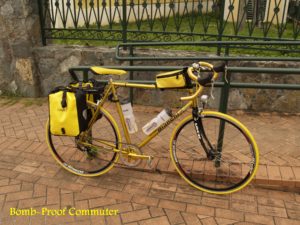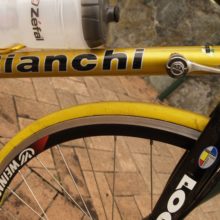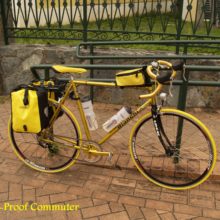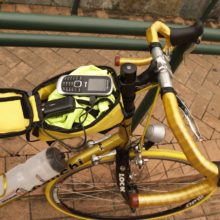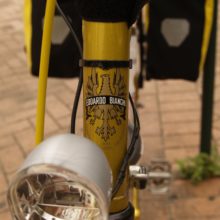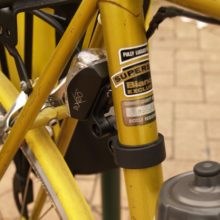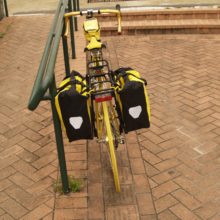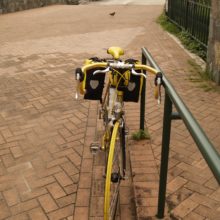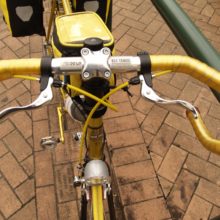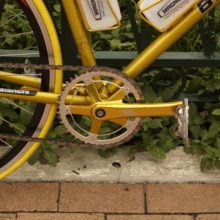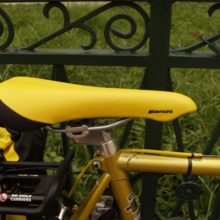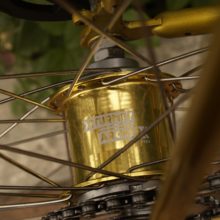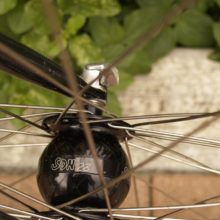Building a Bomb-proof Commuting Bicycle
For the past few years I’ve been commuting and running errands on my long distance touring bicycle. Besides being a most comfortable bike, it
is outfitted with racks and empty panniers so I feel ready for any cargo hauling situation that may arise. Last week while I was out for a
leisurely ride zipping along on a 16 pound carbon-fiber road bike and feeling especially light & free, I asked myself “what exactly were the
differences between a touring bike and a commuting bicycle.” I went over the basic criteria for a commuting bike while I rode along.
(I get the best ideas and insight while on a bike.)
Below are my thoughts:
1. A commuting bike needs to be reasonably light weight for lifting up stairways, into elevators etc.
2. The bicycle should be simple with few moving parts and have very intuitive controls.
3. A commuting bike needs some form of rack and bag system for carrying paperwork, change of clothes, lunch etc.
4. The bike should have flat-free tires to eliminate messy tire changes and delays.
5. It should be relatively narrow to negotiate traffic and/or pedestrians.
6. A commuting bicycle needs a full-time lighting system which is not dependant on batteries, charging or switches.
7. It should have at least two gears, one for the flatland and one for headwinds or hills.
8. The bicycle should have multiple hand positions with quick access to brake levers.
9. A bright color and reflective strips along with always-on lights is advised.
10. Weather proofing for saddle, panniers, electrical devices, drive-train and rider i.e. mud guards/fenders.
Armed with this list, I set out to build my version of the bomb-proof commuting bike.
The Frame:

I enjoy the quick handling of a road specific bike but many of the modern offerings are much too fragile for an every-day commuter. Carbon
-fiber and light weight alloy frames are not capable of being fitted with racks strong enough to carry work related supplies. So I had to seek
out a road frame from a former era. A quick search on Craigs List turned up a large selection of mid 1980’s to early 1990’s quality steel road frames. I settled on a gold 1994 Bianchi Premio frame. The frame had minimal surface rust but the bottom bracket and headset were pretty much shot so these parts had to be replaced. The frame also has a lot of attachment points for water bottles and fenders. Although it is a steel bike, I was surprised at the light weight of the frame. Older quality steel frames are a great starting point for creating a commuter bike.
The Fork:

To save on additional weight, I opted to use a LOOK carbon front fork. I just happened to have this item in the corner of my shop. Most stock
steel road bike forks will also work fine for a commuter bike.
The wheels:
Rear Wheel

This part of the build took a lot of thought. For a commuter bike it is best to avoid greasy derailleur systems, thus internally geared hubs (IGH) are often used on modern commuters. The straight chain-line and enclosed gears are very clean and neat as well as being user friendly. They almost never need adjusting and are very easy to shift, even while standing still at traffic lights. The Bianchi frame has a rear dropout with an over-lock-nut distance (OLD) of 120mm so I was limited in the selection of hubs which were available. I also wanted a hub that would take 36 spokes for extra strength & durability. I finally settled on a Sturmey Archer S2 2Spd Duomatic Kick Shift Hub. This hub has only two speeds, one for flat ground and one for hills. It is a very straight forward and robust hub system. This hub uses no cables or shift levers of any kind but relies on a simple back pedal motion in order to shift gears. As a bonus this hub also came in various colors so I chose gold to match the Bianchi frame. I mated this hub to a Weinmann DP18 deep V style 700c rim with straight 14 gauge stainless spokes. The overall effect was both utilitarian and attractive. The cherry on top was the addition of a recent addition to the cycling world from Korea, the Tannus Tire. These tires are completely air-less. They use a solid polymer cell structure to replace a pneumatic tube & tire. This results in a bike tire that closely matches premium pneumatic city bike tires rolling resistance but with no chance of ever going flat. The tires come in various widths and colors. I chose a 23mm tire in the color yellow to match the bike.
Front Wheel
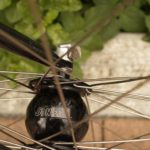
For a front wheel I wanted to use a dynohub of some kind to supply constant power for headlight, tail light and for charging devices such as tablets and cellular phones. Some of the best on the market today are the SON28 hub manufactured in Germany by Wilfried Schmidt Maschinenbau and the PV-8 manufactured in Taiwan by Shutter Precision. I chose a black SON28 dynohub mated to a Weinmann DP18 deep V style 700c rim with 36 straight 14 gauge stainless spokes. This system puts out 6 volts & 3 watts of power capable of running lights and charging peripheral devices simultaneously.
Saddle:
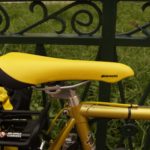
There are many quality saddles available on the market but for comfort and resistance to the weather, my choice is a vintage Bianchi saddle. I located this one in Greece. It is new/old stock and is a very strong waterproof comfortable saddle.
Handlebars & Controls:
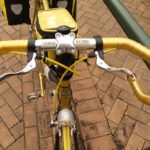
Because this build uses the kick-back hub, there is no need for either front or rear shifters. I found a vintage Italia Modolo 8X Tenos alloy drop-bar from 1995 and outfitted it with both Tektro RL340 Aero Road Bike Brake Levers and Tektro RL720 In-line Brake Levers so the bike can be ridden in an upright position or down in the drops without compromising safety. The bars were wrapped with vintage Benotto nylon bar tape for appearance and protection from the elements. I chose a gold color tape to match the bike frame as well as yellow brake cable housings. These drop-bars are moderately narrow so they work well while riding in traffic.
Rack & Panniers:
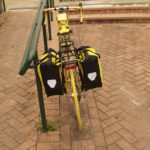
I located a narrow bicycle rack which was supported by rear rack bosses and lower drop-out threaded eyelets. This rack also has a mounting
bracket for a tail-light. Ortlieb panniers were an obvious choice for their waterproofing and I chose a pair of front rollers in a bright yellow color. These smaller panniers fit well on a road bike framework and also set back farther to the rear to eliminate heal strikes. The yellow color with Ortlieb trademark reflective patches are very high visibility.
Lighting:
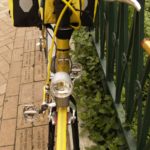
Lighting is provided by a fork mounted Herman’s H-One S headlight at 95 Lux brightness. This is enough power to not only be seen but also see
clearly the roadway ahead even in unlighted areas. Rear tail-light is a rack mounted B&M Toplight Line Plus with stand-light which holds power
for five minutes after a complete stop. I also installed a SPANNINGA Pixeo saddle post tail-light for extra security. All three of these lights are “always on” and use no batteries. I have used this system for years and have yet to burn out a lamp bulb. The switches on most battery operated lights usually will fail before the bulbs do on a dynohub lighting system.
Weight:
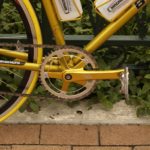
The completed bicycle including clip-less pedals, two water bottles, rack & panniers and lights weighs in at just under 30 pounds. Because of
the compact sleek profile, this bike “feels” a whole lot lighter than that and is easily maneuvered and lifted onto trains, buses or up stairs. Removing one of the panniers and a water bottle cage/bottle reduces the weight to 27lbs 4oz., which is a reasonable weight for a full time steel commuter bike.
In summary, this bicycle has no need for gear adjustments or tire repair for approximately 9,000 – 12,000 miles (depending on road conditions). It is as close to a maintenance free, user friendly, comfortable, safe, commuter bike as can be imagined. For these reasons I call it bomb-proof.
Luce Robnett
